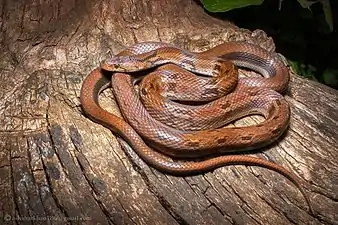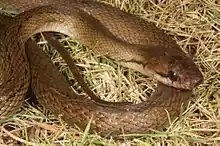Coelognathus
Coelognathus is a genus of seven rat snakes from South and Southeast Asia that were formerly assigned to the genus Elaphe. Based on morphological evidence and protein similarities, in 2001, Helfenberger revalidated the name Coelognathus that had originally been proposed by Leopold Fitzinger in 1843.[1] The distinction between Coelognathus and Elaphe was further supported by mitochondrial DNA sequence and additional morphological evidence in 2005.[2]
| Coelognathus | |
|---|---|
 | |
| Montane trinket snake (C. helena monticollaris) | |
| Scientific classification | |
| Kingdom: | Animalia |
| Phylum: | Chordata |
| Class: | Reptilia |
| Order: | Squamata |
| Suborder: | Serpentes |
| Family: | Colubridae |
| Subfamily: | Colubrinae |
| Genus: | Coelognathus Fitzinger, 1843 |

Species
These species are recognized:[3]
- Coelognathus enganensis (Vinciguerra, 1892)
- Coelognathus erythrurus (A.M.C. Duméril, Bibron & A.H.A. Duméril, 1854) – Philippine rat snake
- Coelognathus flavolineatus (Schlegel, 1837) – yellow-striped rat snake
- Coelognathus helena (Daudin, 1803) – trinket snake
- Coelognathus philippinus (Griffin, 1909) – reddish rat snake
- Coelognathus radiatus (F. Boie, 1827) – copperhead rat snake
- Coelognathus subradiatus (Schlegel, 1837) - Indonesian rat snake
Nota bene: A binomial authority in parentheses indicates that the species was originally described in a genus other than Coelognathus.
References
- Helfenberger N. (2001). "Phylogenetic relationships of Old World ratsnakes based on visceral organ topography, osteology, and allozyme variation". Russian Journal of Herpetology. 8: 1–62.
- Utiger U, Schätti B, Helfenberger N (2005). "The Oriental colubrine genus Coelognathus Fitzinger, 1843, and classification of Old and New World racers and ratsnakes (Reptilia, Squamata, Colubridae, Colubrinae)" (PDF). Russian Journal of Herpetology. 12 (1): 32–53.
- "Coelognathus ". The Reptile Database. www.reptile-database.org.
Further reading
- Fitzinger L. 1843. Systema Reptilium, Fasciculus Primus, Amblyglossae. Vienna: Braumüller & Seidel. 106 pp. + indices. (Coelognathus, new genus, p. 26). (in Latin).
This article is issued from Wikipedia. The text is licensed under Creative Commons - Attribution - Sharealike. Additional terms may apply for the media files.